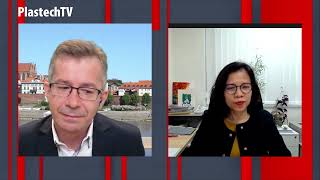BASF has already developed various barrier solutions that are applied to the internal surface of the cardboard box. These extremely thin coatings are made from polymers, in other words macromolecules made up of many repeating smaller molecules. Barrier coatings that are only 10 to 15 micrometers thick - by comparison, a hair is 120 micrometers thick - already protect food from the contaminants for up to three years. Products like noodles that remain for an average of 15 to 24 months in the packages, are thereby reliably protected. "The most important requirement for the barriers is that the breakthrough time - which is the period until a barrier can become permeable and allow health hazardous substances to penetrate into the food - is longer than the shelf-life of the packaged product," explains Diehl.
"Our barrier coatings can be imagined as being like a close meshwork that allows only certain molecules to pass through," continues Diehl. Only very small molecules like water vapor, for example, can pass. Larger molecules like mineral oil residues cannot cross. In addition, the polar nature of the BASF barriers hinders the migration of the molecules.
Developing the barrier effect for large molecules was not the only challenge when designing the various coating solutions. Dr. Carmen Cimpeanu of BASF Materials and Systems Research explains: "The coating simultaneously has to be flexible enough to prevent fractures forming when folding the cardboard ensuring the barrier remains intact."
When the coating has finally fulfilled its task and the foods have been consumed, the polymer film should be easy to remove from the paper packaging. Because when the cardboard is recycled again, the polymer film must not get in the way but should be capable of being easily removed in the recycling process. Only then can the recycled paper be readily reprocessed back into cardboard packaging that will protect the next batch of muesli, noodles and co.
"Today, packaging has to protect not only against mechanical stress but also against contaminants," said Michael Avemarg, Innovation Manager Materials at Europe's leading manufacturer of folding cartons and boxes, Van Genechten in Kempten (Germany). "Laboratories have increasingly accurate analytical methods at their disposal and can track down undesired substances ever more effectively. New limits are being established which we as packaging manufacturers have to comply with. This also applies to mineral oil constituents in cardboard. We anticipate that strict limits will be imposed and have already modified our production lines. To develop optimal coating solutions for the manufacturing process, we are already cooperating with BASF and testing products in our plants. For the jointly developed WLC Food Safe coating based on BASF's plastic Ultramid, in September we won the German Packaging Prize 2013."
"The trend is moving mainly towards sustainable packaging. The use of renewable resources and recycling processes will play a major role in future. BASF's biobased coating variant ecovio, which we have already successfully tested in our plants, is moving in this direction. Additional functions such as higher heat resistance will also play an increasing role in packaging. New media are also becoming ever more present in the information applied to packages: there are more links to homepages or interactive competitions that consumers can use directly with their smartphones. And the packaging can be supplemented with virtual additional information, animated or even shown in 3D, by means of augmented reality functions.
Protective layers made from BASF materials
- Pages:
- 1
- 2



